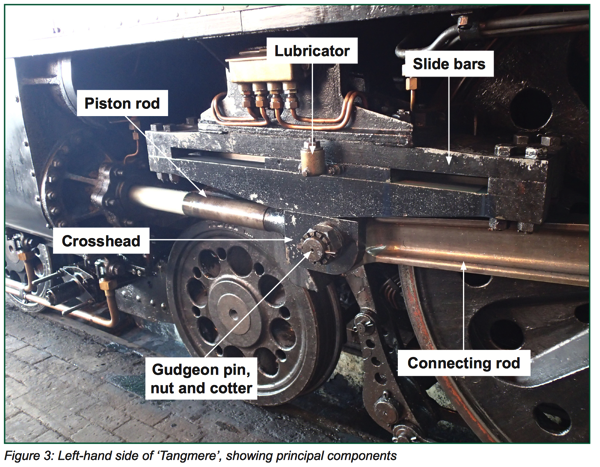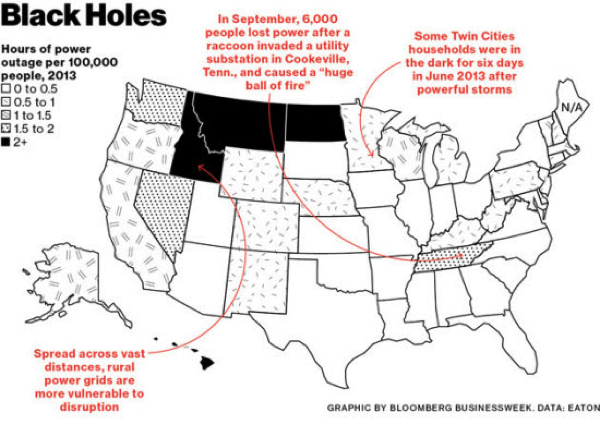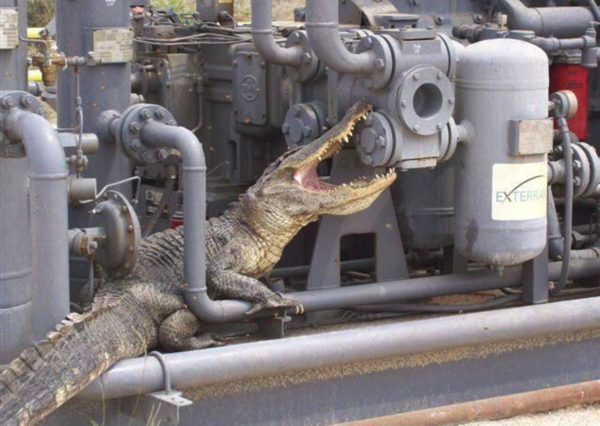
A mechanic opened the wrong end of a filter causing oil to spray on hot piping. The immediate flash fire caused extensive damage at the Martin Drake power plant run by Colorado Springs Utilities.
See the Colorado Springs Fire Department report here:

A mechanic opened the wrong end of a filter causing oil to spray on hot piping. The immediate flash fire caused extensive damage at the Martin Drake power plant run by Colorado Springs Utilities.
See the Colorado Springs Fire Department report here:

The UK RAIB has issued an accident report about the failure of a locomotive near Winchfield, UK. This was a near-miss for a derailment. Here is the Summary:
At about 18:50 hrs on Saturday 23 November 2013, while a steam-hauled passenger train from London Waterloo to Weymouth was approaching Winchfield in Hampshire at about 40 mph (64 km/h), the right-hand connecting rod of the locomotive became detached at its leading end (referred to as the small end), which dropped down onto the track. The driver stopped the train immediately, about one mile (1.6 km) outside Winchfield station. There was some damage to the track, but no-one was hurt. The accident could, in slightly different circumstances, have led to derailment of the train.

The immediate cause of the accident was that the small end assembly came apart, allowing one end of the connecting rod to drop to the ground. The reasons for this could not be established with certainty because some components could not be found after the accident. It is possible that the gudgeon pin securing nut unwound following breakage of the cotter and previous loosening of the nut. A possible factor is that the design of some components had been modified during the restoration of the locomotive some years earlier, without full consideration of the possible effect of these changes. There were deficiencies in the design and manufacture of the cotter. It is also possible, but less likely, that the securing nut split due to an inherent flaw or fatigue cracking.
RAIB has made four recommendations, directed variously to West Coast Railway Company, the Heritage Railway Association, and the Main Line Steam Locomotive Operators Association. They cover the maintenance arrangements for steam locomotives used on the national network, a review of the design of the small end assembly on the type of locomotive involved in the accident, guidance on the design and manufacture of cotters, and assessment of risk arising from changes to the details of the design of locomotives.
For the complete report, see:
http://www.raib.gov.uk/cms_resources.cfm?file=/140616_R132014_Winchfield.pdf
The article starts with …
“Power outages in the United States are up an astonishing 285% since 1984. The U.S. ranks last among the top nine Western industrialized nations in the average length of outages. That dismal performance costs American businesses as much as $150 billion every year according to the EIA.“
It also has a map of power outage by state:

CLICK HERE to see the whole article.
OSHA General Duty Clause Citations: 2009-2012: Food Industry Related Activities
Doing a quick search of the OSHA Database for Food Industry related citations, it appears that Dust & Fumes along with Burns are the top driving hazard potentials.
Each citation fell under OSH Act of 1970 Section 5(a)(1): The employer did not furnish employment and a place of employment which were free from recognized hazards that were causing or likely to cause death or serious physical harm to employees in that employees were exposed……
Each company had to correct the potential hazard and respond using an Abatement Letter that includes words such as:
The hazard referenced in Inspection Number [insert 9-digit #]
for violation identified as:
Citation [insert #] and item [insert #] was corrected on [insert
date] by:
Okay so you have a regulatory finding and listed above is one of the OSHA processes to correct it, sounds easy right? Not so fast…..
….are the findings correct?
….if a correct finding, are you correcting the finding or fixing the problems that allowed the issue?
….is the finding a generic/systemic issue?
As many of our TapRooT® Client’s have learned, if you want a finding to go away, you must perform a proper root cause analysis first. They use tools such as:
o SnapCharT®: a simple, visual technique for collecting and organizing information quickly and efficiently.
o Root Cause Tree®: an easy-to-use resource to determine root causes of problems.
o Corrective Action Helper®: helps people develop corrective actions by seeing outside the box.
First you must define the Incident or Scope of the analysis. Critical in analysis of a finding is that the scope of your investigation is not that you received a finding. The scope of the investigation should be that you have a potential uncontrolled hazard or access to a potential hazard.
In thinking this way, this should also trigger the need to perform a Safeguard Analysis during the evidence collection and during the corrective action development. Here are a few blog articles that discuss this tool we teach in our TapRooT® Courses.
Monday Accident & Lesson NOT Learned: Why Do We Use the Weakest Corrective Actions From the Hierarchy of Safeguards?http://www.taproot.com/archives/28919#comments
Root Cause Analysis Tip: Analyze Things That Go Right … The After-Action Review
http://www.taproot.com/archives/43841
If you have not been taking OSHA Finding to the right level of action, you may want to benchmark your current action plan and root cause analysis process, see below:
BENCHMARKING ROOT CAUSE ANALYSIS
http://www.taproot.com/archives/45408
We hope you enjoy this new format of our Instructor Root Cause Tips. Today we have Ken Reed, TapRooT®/Equifactor® Instructor and Partner, discussing “What Makes a World Class Root Cause Analysis System?”. Be sure to pay attention to the 7 Strengths of TapRooT® that he discusses.
Click here to learn more about our courses where you can learn root cause analysis and implement in your own workplace.
===============
Was this tip helpful? Check out more short videos in our series:
TapRooT® & Healthcare: Getting the Most from Your Sentinel Event Investigation with Ed Skompski (Click here to view tip.)
Prevent Equipment Failures with Ken Reed (Click here to view tip.)
Be Proactive with Dave Janney (Click here to view tip.)
Airplane loses power during take off at a Kansas Airport and plane strikes building. Pilot of the King Air Aircraft that crashed and 3 people working in a flight simulator inside that building are dead. Read more here at KAKE News in Wichita, KS.
I post this because of the debates and blame that are going to ensue. Was it just one thing, the plane crashing, that caused this issue to occur? Was it the location of all the flight buildings in the vicinity of an airport. Was this just a “freak accident”. So much more to learn… I hope they get it right so it does not happen again.
Tune in to this week’s TapRooT® Instructor Root Cause Analysis Tip with Ken Reed. He briefly discusses the importance of using Equifactor® proactively in order to prevent equipment failures from ever happening. Among the many uses of TapRooT®, using it proactively is one of the most important. Keep the investigations to a minimum if you can help it!
For more information on Equifactor® and the courses we offer for it, click here.
===============
Was this tip helpful? Check out more short videos in our series:
Be Proactive with Dave Janney (Click here to view tip.)
Conduct Real-Time Peer Reviews with Mark Paradies (Click here to view tip.)
What Makes a World-Class Root Cause Analysis System with Ken Reed (Click here to view tip.)
Want to know how to save over half the price of attending the 3-Day TapRooT®/Equifactor® Equipment Troubleshooting & Root Cause Failure Analysis Course PLUS save one day’s living expenses?
Go to the Special 2-Day Equifactor® Equipment Troubleshooting and Root Cause Analysis Course!
We are offering a special 2-Day Equifactor®/TapRooT® course (only offered one time this year!) as a pre-Summit course June 1 and 2, 2015 in Las Vegas, Nevada. This pre-Summit course is only $1,295, but if you register for the TapRooT® Summit June 3 – 5, you can take an additional $200 off the price, making it only $1,095 – less than half of the normal price of the 3-day course! Plus, since it is taught in just two days, you will save one day’s travel expenses!
This is a perfect opportunity for those who are planning to be part of the Equipment Reliability & Maintenance track at the Summit — where Heinz Bloch and our panel of experts will be offering innovative solutions to the biggest equipment reliability problems facing the industry today. Take this pre-Summit course, and then join the ranks of a select group of industry leaders at the Summit!
This course is taught by Equifactor® Program Manager, Ken Reed. Below, he gives us a brief overview of Equifactor® and talks about how to use this tool proactively.
In just two days learn the basics of the TapRooT® System for finding the root causes AND the Equifactor® Equipment Troubleshooting Technique for Root Cause Failure Analysis of Equipment Problems. Once you find the real root causes using this systematic process, learn to develop effective fixes that will keep problems from happening again. Check your corrective action effectiveness using the SMARTER technique. Also, learn to find and fix equipment problems proactively BEFORE an accident or incident occurs and to analyze the Safeguards that keep problems from happening or from getting worse once a single Safeguard fails.
LEARN MORE about this special course: http://www.taproot.com/taproot-summit/pre-summit-courses#Equifactor
REGISTER TODAY on our website: http://www.taproot.com/taproot-summit/register-for-summit
FOR MORE INFORMATION about the 2015 TapRooT® Summit, download a brochure from the Summit Website: http://www.taproot.com/summit.php
See the article by Heinz Bloch at:
http://www.hydrocarbonprocessing.com/IssueArticle/3440210/Archive/The-true-cost-of-poor-quality.html
And then attend the Equipment Reliability and Troubleshooting Track at the 2015 Global TapRooT® Summit and hear Heinz speak about the business end of equipment reliability and the foundations of Equifactor®. See the complete Summit schedule at:
Do you have incidents that happen over and over again?
Do you have repeat equipment failures?
Does your hospital have similar sentinel events that aren’t solved by your root cause analysis?
How much are these repetitive problems costing your company?
Stop making excuses and try something NEW that can help you stop repetitive problems…
IDEA #1: Attend at TapRooT® Course to stop repeat incidents.
Choose from the:
These courses are guarantee to help you find root causes that you previously would have overlooked and develop corrective actions that both you and your management agree are more effective.
IDEA #2: Attend the Creative Corrective Actions Course.
Hurry, this course is only offered on June 1-2, prior to the TapRooT® Summit. If your creativity for solving problems is getting stale, this is the course you need to attend.
IDEA #3:: Attend the 2015 Global TapRooT® Summit in Las Vegas on June 3-5.
The Summit is a proven place to network and learn valuable best practices that can help you solve your toughest problems. Each Summit is unique, so you don’t want to miss one. And this year’s Summit is rapidly approaching. Register today at:
Don’t end up “fixing” the same equipment problems over and over again. Don’t let equipment issues cause quality, operations, and safety issues. Find the real root causes of your equipment reliability issues and develop effective fixes that will keep them from happening again by using this systematic process.
Did you know that we have 3-day and 1-day courses? What’s the difference? 3-Day Courses include the 1-Day Equifactor® Course along with the 2-Day Incident Investigation and Root Cause Analysis Course so you have it all in one. The 1-Day courses are just the separate Equifactor® course that requires a previously taken 2-Day course along with it, not necessarily all in one trip.
Why take an Equifactor® course? You will not only receive invaluable knowledge for your business, but also a Free single-user copy of TapRooT® Software. (A $2890 Value!) You can’t get a better deal than that.
Still deciding? Watch the video below to hear our Equifactor® instructor, Ken Reed, talk about why this course is right for you.
Steps to register for the course and Free Software.
1) CLICK HERE
2) Select a 1-Day Equifactor® Course of your choice (Having already taken a 2-Day course or accompanying it with a 2-Day course)
3) Register for the course and add it to your cart
4) Done!
Upcoming Equifactor® Public Courses:
Sale, Australia | May 15, 2015
GLOBAL TapRooT® PRE SUMMIT and SUMMIT

OSHA General Duty Clause Citations: 2009-2012: Food Industry Related Activities
Doing a quick search of the OSHA Database for Food Industry related citations, it appears that Dust & Fumes along with Burns are the top driving hazard potentials.
Each citation fell under OSH Act of 1970 Section 5(a)(1): The employer did not furnish employment and a place of employment which were free from recognized hazards that were causing or likely to cause death or serious physical harm to employees in that employees were exposed……
Each company had to correct the potential hazard and respond using an Abatement Letter that includes words such as:
The hazard referenced in Inspection Number [insert 9-digit #]
for violation identified as:
Citation [insert #] and item [insert #] was corrected on [insert
date] by:
Okay so you have a regulatory finding and listed above is one of the OSHA processes to correct it, sounds easy right? Not so fast…..
….are the findings correct?
….if a correct finding, are you correcting the finding or fixing the problems that allowed the issue?
….is the finding a generic/systemic issue?
As many of our TapRooT® Client’s have learned, if you want a finding to go away, you must perform a proper root cause analysis first. They use tools such as:
o SnapCharT®: a simple, visual technique for collecting and organizing information quickly and efficiently.
o Root Cause Tree®: an easy-to-use resource to determine root causes of problems.
o Corrective Action Helper®: helps people develop corrective actions by seeing outside the box.
First you must define the Incident or Scope of the analysis. Critical in analysis of a finding is that the scope of your investigation is not that you received a finding. The scope of the investigation should be that you have a potential uncontrolled hazard or access to a potential hazard.
In thinking this way, this should also trigger the need to perform a Safeguard Analysis during the evidence collection and during the corrective action development. Here are a few blog articles that discuss this tool we teach in our TapRooT® Courses.
Monday Accident & Lesson NOT Learned: Why Do We Use the Weakest Corrective Actions From the Hierarchy of Safeguards?http://www.taproot.com/archives/28919#comments
Root Cause Analysis Tip: Analyze Things That Go Right … The After-Action Review
http://www.taproot.com/archives/43841
If you have not been taking OSHA Finding to the right level of action, you may want to benchmark your current action plan and root cause analysis process, see below:
BENCHMARKING ROOT CAUSE ANALYSIS
http://www.taproot.com/archives/45408
Do you like quick, simple tips that add value to the way you work? Do you like articles that increase your happiness? How about a joke or something to brighten your day? Of course you do! Or you wouldn’t be reading this post. But the real question is, do you want MORE than all of the useful information we provide on this blog? That’s okay – we’ll allow you to be greedy!
A lot of people don’t know we have a company page on LinkedIn that also shares all those things and more. Follow us by clicking the image below that directs to our company page, and then clicking “Follow.”
We also have a training page where we share tips about career/personal development as well as course photos and information about upcoming courses. If you are planning to attend a TapRooT® course or want a job for candidates with root cause analysis skills, click the image below that directs to our training page and then click “Follow.”
Thank you for being part of the global TapRooT® community!
Don’t end up “fixing” the same equipment problems over and over again. Don’t let equipment issues cause quality, operations, and safety issues. Find the real root causes of your equipment reliability issues and develop effective fixes that will keep them from happening again by using this systematic process.
Did you know that we have 3-day and 1-day courses? What’s the difference? 3-Day Courses include the 1-Day Equifactor® Course along with the 2-Day Incident Investigation and Root Cause Analysis Course so you have it all in one. The 1-Day courses are just the separate Equifactor® course that requires a previously taken 2-Day course along with it, not necessarily all in one trip.
Why take an Equifactor® course? You will not only receive invaluable knowledge for your business, but also a Free single-user copy of TapRooT® Software. (A $2890 Value!) You can’t get a better deal than that.
Still deciding? Watch the video below to hear our Equifactor® instructor, Ken Reed, talk about why this course is right for you.
Steps to register for the course and Free Software.
1) CLICK HERE
2) Select a 1-Day Equifactor® Course of your choice (Having already taken a 2-Day course or accompanying it with a 2-Day course)
3) Register for the course and add it to your cart
4) Done!
Upcoming Equifactor® Public Courses:
We hope you enjoy this new format of our Instructor Root Cause Tips. Today we have Ken Reed, TapRooT®/Equifactor® Instructor and Partner, discussing “What Makes a World Class Root Cause Analysis System?”. Be sure to pay attention to the 7 Strengths of TapRooT® that he discusses.
Click here to learn more about our courses where you can learn root cause analysis and implement in your own workplace.
===============
Was this tip helpful? Check out more short videos in our series:
TapRooT® & Healthcare: Getting the Most from Your Sentinel Event Investigation with Ed Skompski (Click here to view tip.)
Prevent Equipment Failures with Ken Reed (Click here to view tip.)
Be Proactive with Dave Janney (Click here to view tip.)

Do you know what equipment failure is costing your company?
An ocean going drilling rig had a failed oil/water separator. The device is a required piece of pollution control equipment. When it failed, someone made a makeshift fix to keep things operating. The Coast Guard discovered the makeshift repair and fined the company $12.2 million dollars.
In this example, the cost of failure was in a Coast Guard fine. But often the cost of failure occurs because of lost production, repair costs, and unnecessary repetitive repairs.
What are you doing to understand your equipment failures?
You should be using Equifactor® to improve your equipment troubleshooting and the TapRooT® Root Cause Analysis System to improve your root cause analysis.
Equifactor® Equipment Troubleshooting has many troubleshooting tables for common pieces of equipment. But what if a piece of equipment doesn’t have a troubleshooting table? You can get your company and vendor experts together to make a custom troubleshooting table so that everybody can troubleshooting problems using the tables and get the results the experts get.
Don’t wait until a:
Act now! Send someone to one of our public 3-Day TapRooT®/Equifactor® Equipment Troubleshooting & Root Cause Analysis Course. Find out how it can help you stop equipment reliability problems with proven equipment troubleshooting and root cause analysis tools. See the upcoming course dates at this link:
This is not the Friday Joke.
Root cause analysis has become so popular that politicians are now calling for companies to complete a root cause analysis and implement corrective actions.

Massachusetts Governor Charlie Baker wrote a letter to Entergy Nuclear Operations calling on them to “… perform an appropriate root cause analysis …” of safety issues the NRC had announced “… and to complete all necessary repairs and corrective actions.”
The letter was in response to an unplanned shutdown at the Pilgrim nuclear power plant in Plymouth, Massachusetts caused by a malfunctioning main steam stop valve (one of eight valves that is designed to shut off steam from the reactor to the turbine that generates electricity). The valve had failed shut.
For all those not in the nuclear industry, note that in the nuclear industry, a failure of one of eight valves that failed in the safe direction (shut) and that has backup safety systems (both manual and automatic) can get a public letter from the Governor and attention from a federal regulator. Imagine if you had this level of safety oversight of your systems. Would your equipment reliability programs pass muster?
The response from Entergy to the Governor noted that, “We have made changes and equipment upgrades that have already resulted in positive enhancements to operational reliability.” (Note that these fixes occurred in less than a week after the original mechanical failure.)
For more about the story, see: http://www.wbur.org/2015/09/03/baker-pilgrim-nuclear
Note the local NPR story at the link above is inaccurate in its description of the problem and the mechanical systems.
For those interested in improving equipment reliability and root cause analysis, consider attending one of our 3-Day TapRooT®/Equifactor® Equipment Troubleshooting and Root Cause Analysis Courses. See the upcoming course list at:
http://www.taproot.com/store/3-Day-Courses/
Now for the biggest question …
When will government authorities start applying root cause analysis
to the myriad of problems we face as a nation and start implementing appropriate corrective actions?